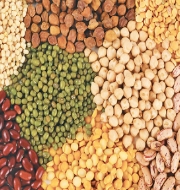Issues Around Pulse Production and Pulse Buffer Stocks
The most commonly grown pulses in India include Bengal gram, Pigeon Pea, Lentil, Moong bean, Urd Bean, Lobia etc. Apart from their use in staple diet, pulses have widespread uses including fodder and manure. Pulses also promote sustainable agriculture as they decrease greenhouse gases & increase soil health through nitrogen fixation.
India is largest producer and consumer of pulses but still one fourth of the pulse demand is fulfilled via imports. The low production of the pulses has frequently resulted in huge spikes in the pulse prices and due to huge inflation in 2015, the government established a committee under Chief Economic Advisor Arvind Subramanian, to look after the country’s pulse production, trade and distribution. This committee suggested creation of a buffer stock in pulses.
Reasons for low pulses production
There are several biotic and abiotic reasons for low production of pulses in the country. The biotic factors include diseases such as pod borer, pod fly, Fusarium wilt, and sterility mosaic disease. The abiotic factors are as follows:
- Expansion of irrigation facilities in northern and western India led to displacement of pulses by wheat, rice, and maize in large area. Due to this, more than 80% of the pulses production areas was limited to the Rainfed region. Thus, pulses are highly subjected to drought and heat stress.
- Though the government provides MSPs to around 26 crops including pulses yet, the benefits of MSP has been largely limited to the cereal crops. This has made the farmers to treat pulses as secondary crops, and they rarely invest in any kind of technological progress, mechanization, good quality seeds & fertilizers for pulses production.
- Unlike wheat and rice, pulses are not grown in too many places around the world. This makes import of pulses problematic.
- High prices of pulse seeds increase the cost of production. Pulse seeds production is mainly confined to public sector. Private seeds companies restrain from investing in pulse seeds production because these seeds are of open pollinating varieties and can be saved and used again by the farmers.
- Too less has been done in research and development (R&D) and to enhance the genetic production potential of pulses.
Government Policy and Pulse Buffer Stocks
The government policy on pulse included hike in MSP and encouraging farmers to produce pulses. Further, in the times of pulse crisis, the government generally resorts to import of pulses from other countries and blocking exports of the same from here. In 2015, the government also established a buffer stock of pulses to check price volatility. This helped farmers get remunerative prices, and the buffer stock has reached to nearly 5% of the domestic production. Production of pulses has also increased in south India because of adoption of new short-duration, high yielding varieties of seeds.To boost the National Food Security Scheme, the Indian Council for Agricultural Research (ICAR) is developing hubs for seed production across the country with an aim to providing seeds of various pulses to farmers at affordable prices. Government has proposed to hire land abroad for farming of pulses. This would reduce the necessity for import and help to meet the domestic demand.
Current Status and Issues: The Supply Gut
Increase in MSP for pulses, high procurement for buffer stock, and good monsoon last year has led to record sowing and production of pulses especially tur dal. Further, ban on exports, restrictions on stocking by private agencies and absence of futures trading in agricultural commodities have led to supply gut in the market. All above factors have now decreased the market price for pulses much below their MSPs. This in turn has made the farmers to sell their produce to traders at prices much lower than MSPs. The government in order to reduce the impact of this supply gut has increased the limit of buffer stock–produce, but the government agencies are not ready to stockpile pulses due to storage space problems. Further, the government is unable to check the nexus between politicians, government officials and grain traders. Grain traders are always interested in ensuring minimal payout to farmers for their purchases. This can be only possible if government policies for farmers are weak or government is unable to implement its policies. For example, dismantling of agriculture produce market committee, setting up private marketing yards, enhancing electronic national agriculture market (e-NAM) are some of the ongoing reforms to provide more options to farmers. But the pace of their implementation has been too slow to make many changes in the existing system.


